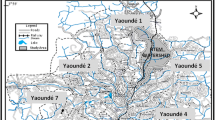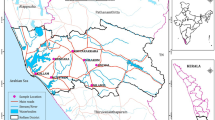Abstract
Analysis of the total heavy metal (Cr, Cd, Pb, As, Cu, Ni, Zn, Co) concentration was performed on 33 soil samples taken from different profiles and soil types in a highly urbanized and industrial sector of Addis Ababa, central Ethiopia. They were analyzed using aqua regia extraction coupled with a four-stage sequential extraction (SE) procedure. The objectives of the analysis were to investigate the degree of soil heavy metal contamination, its binding forms, mobility and the implications for the groundwater resource. The results show a relatively high content of the analyzed trace metals in the soil attributed to anthropogenic and geogenic sources. Although most of the trace metals are found in the upper few centimeters of the residual soils, because of churning processes within the black cotton soils, vertical distribution of the trace metals is complex. According to the heavy metal SE analysis, the major heavy metal contribution is from the residual followed by the hydroxide phases. Groundwater heavy metal contamination is present with more than 90 and 50% of the analyzed groundwater samples exceeding WHO guidelines for Cr and Cd, respectively. Since the degree of soil heavy metal contamination has apparently not surpassed the soil’s buffering capacity, it appears that the transport path of these toxic metals to the groundwater is through fractures, joints, and related preferential flow paths.



Similar content being viewed by others
References
AAWSA, BCEOM, SEURECA and Tropics (2000) Addis Ababa Water Supply Project Stage-IIIA Groundwater-Phase II, Modeling of Akaki Well field, V1, main report, Addis Ababa Water and Sewerage Authority, Addis Ababa, Ethiopia, p 54
Alemayehu T (2001) The impact of uncontrolled waste disposal on surface water quality in Addis Ababa, Ethiopia. SINET: Ethiop. J Sci 24(1):93–104
Alloway BJ, Ayres DC (1997) Chemical principles of environmental pollution, 2nd edn. Chapman & Hall, London, 395 pp
Ashley RP, Lloyd JW (1978) An example of the use of factor analysis and cluster analysis in groundwater chemistry interpretation. J Hydrol 39:355–364
Brown CE (1998) Applied multivariate statistics in geohydrology and related sciences. Springer, Berlin Heidelberg New York, 248 pp
Central Statistical Authority (1999) The 1994 population and Housing census of Ethiopia, Results for Addis Ababa, Addis Ababa
Deutscher Normenausschuss (1984) DIN 38414, Teil 4- Bestimmung der Eluierbarkeit mit wasser (S-4) and Teil 7—Koenigswasser-Aufschluess zur Bestimmung von Gesamptgehalten (S 7). Deutsches Institut fuer Normung e. V., Berlin, Germany
Dües G (1987) Untersuchungen zu den Bindungsformen und ökologisch wirksamen Fraktionen ausgewählter toxischer Schwermetalle in ihrer Tiefenverteilung in Hamburger Boeden- Hamburger Boedenkundliche Arbeiten 9:265
Fiedler HJ, Roesler HJ (eds) (1988) Spurenelemente in der Umwelt. Enke-Verlag, Stuttgart, p 278
Girma A (1994) Hydrogeology of Akaki area. Unpublished M.Sc. Thesis. Addis Ababa University, Addis Ababa, p 136
Gizaw B (2002) Hydrochemical and environmental investigation of the Addis Ababa region, Ethiopia. Ph.D. Thesis, Faculty of Earth and Environmental Sciences, Ludwig-Maximilians-University of Munich, p 157
Hem JD (1989) Study and interpretation of the chemical characteristics of natural waters, 3rd edn. US Geol Surv Water Supply Paper 2254
Matschullat J, Ottenstein R, Reimann C (2000) Geochemical background- can we calculate it? Environ Geol 39:990–1000
Rawlins BG, Lister TR, Mackenzie AC (2002) Trace-metal pollution of soils in Northern England. Environ Geol 41:612–620
Schleyer R, Kerendorf H (1992) Die Grundwasserqualitaet westdeutscher Trinkwasserresourcen.VCH-Velagsgesellschaft, Weinheim, p 245
Shuman LM (1985) Fractionation method for soil microelements. Soil Sci 140:11–22
Sposito G (1998) Bodenchemie. Enke, Stuttgart, p 230
SPSS Inc. (1999) SPSS for Windows Rel. 10.0.1, Chicago
Tale S (2000) The extent of surface and groundwater pollution in Addis Ababa. Unpublished M.S. thesis, Addis Ababa University, Addis Ababa
Tessier A, Campbell PGC, Bisson M (1979) Sequential extraction procedure for the speciation of particulate trace metals. Anal Chem 51(7):844–851
Wisotzky F, Cremer N (2003) Sequential extraction procedure in columns. Part 1: development and description of a new method. Environ Geol 44:799–804 DOI 10.1007/s00254-003-0800.7
World Health Organization WHO (2004) Guidelines for drinking-water quality, 3rd edn. World Health Organization, Geneva
Yong RN, Yaacob WZW, Bentley SP, Harris C, Tan BK (2001) Partitioning of heavy metals on soil samples from Column tests. Eng Geol 60:307–322
Acknowledgements
The authors are grateful to the German Academic Exchange Service (DAAD) for the partial financial support of the field research work and a Ph.D. grant to the first author. Thanks to Dr. F. Wisotzky, Mr. O. Schuebbe, Mr. D. Barnke, Dr. S. Bender (Department of Applied Geology, Ruhr University of Bochum) for the assistance received in analyzing soil and water samples in the laboratory. Thanks to Dr. R. Bussert (Institute of Applied Geosciences, TU-Berlin) for XRD analysis of some of the soil samples and to Dr. T. Fockenberg (Institute of Geology, Mineralogy and Geophysics, Ruhr University of Bochum) for XRF analysis of the rock samples. Lastly the authors would like to thank Mr. E. Parks and the anonymous reviewer for improving the quality of the manuscript.
Author information
Authors and Affiliations
Corresponding author
Rights and permissions
About this article
Cite this article
Demlie, M., Wohnlich, S. Soil and groundwater pollution of an urban catchment by trace metals: case study of the Addis Ababa region, central Ethiopia. Environ Geol 51, 421–431 (2006). https://doi.org/10.1007/s00254-006-0337-7
Received:
Accepted:
Published:
Issue Date:
DOI: https://doi.org/10.1007/s00254-006-0337-7




